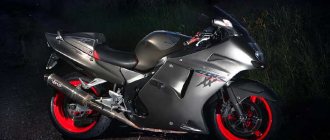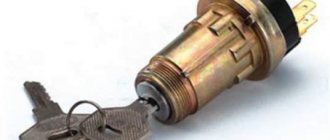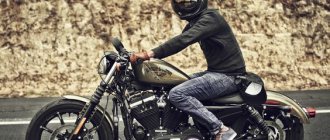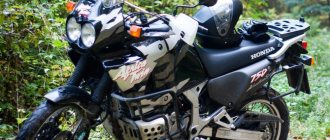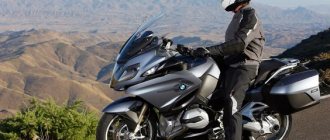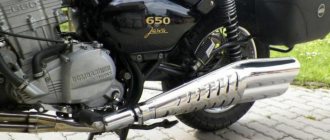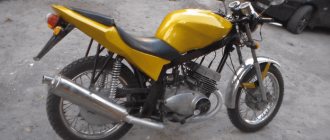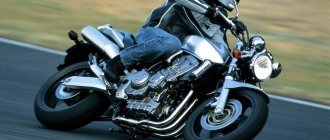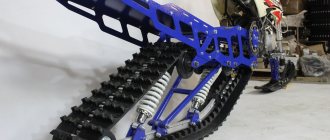How to choose a battery for a scooter
There are two main types of rechargeable batteries.
Liquid acid is much cheaper and requires maintenance. It needs to be filled with distilled water periodically. Such a battery is insensitive to sharp turns. A good choice for those who do not want to spend money extra and are not afraid to work with their iron horse. The gel battery is expensive, but requires almost no maintenance. More common on Japanese models because it is sensitive to other electronics. It is extremely difficult to restore, so it is recommended primarily for those who do not intend to spend a lot of time on the scooter.
How to start a motorcycle correctly?
How to start a motorcycle correctly?
Find out in advance how to start your motorcycle correctly when the most common difficulties arise. Problems usually appear when starting a cold engine, if the battery is dead or the starter is broken. The step-by-step instructions below will help novice motorcyclists avoid unnecessary worries.
Action number one
Try to figure out what is preventing the engine from starting normally.
Pay attention to the indicator that shows the presence of gasoline. Is the fuel valve in the open position, the footrest is raised, neutral and the ignition are on, but the motorbike does not start? It's a dead battery or a broken starter.
You'll have to figure out how to start a motorcycle by pushing.
We start from the pusher
· Goal: Automatically start the engine with the transmission connected by pushing the motorcycle forward.
· Put a low gear - first or second (second is best suited for most bikes). How to do this with a manual transmission: depress the clutch and move the gear selector down with your foot. We move from first gear to second: squeeze the clutch lever and move the selector by moving your foot up.
· You can start a motorcycle if you push it up to about ten kilometers per hour, how can you ensure this? First of all, foresee a long path ahead without obstacles. Leave a little space on the sides of the movement path in case of an emergency - if control over the device is lost when the engine is turned on.
· How to start a motorcycle with virtually no effort: ride down a hill with enough incline to quickly gain speed. There is no need to run and push the motorcycle in this case, you can calmly sit on it. The main thing is the confidence that you will maintain control over the steering.
· When the speed is 10 km/h, you need to smoothly release the clutch and slightly add gas. At this moment, the engine starts, and the driver should press the clutch again to prevent the vehicle from driving away.
· After the engine has started, you need to ensure its reliable operation. To prevent it from stalling, set the engine to medium speed with the clutch depressed. Adding revs will help recharge a dead battery.
We figured out how to properly start a motorcycle from a pusher, now we recommend riding a little to increase the battery charge. You can spin the engine while standing so that the battery gains energy. If the battery is old, it makes sense not to turn off the engine and immediately drive up to a mechanic. If the problem lies elsewhere, it would also be a good idea to consult a mechanic.
How to safely start a motorcycle, the main rules:
· a helmet must be worn by the driver;
· a busy road is too dangerous to push start;
· since the motorcycle is quite heavy, find a downhill slope and make sure you can control the movement;
· if you have little experience in repairing motorcycles, take the bike to a workshop and let a professional handle it.
How to properly start a motorcycle with a cold engine:
1. Open the fuel valve and pull the enricher towards you, if your model has one.
2. Press the carburetor float for 10 seconds until the fuel arrives.
3. Check whether the motor vehicle is in neutral by lightly pressing the electric starter.
4. Start the ignition. If the starting enrichment is missing, turn the throttle handle a quarter of the way and turn on the electric starter.
Warning: simultaneous action of gas and starter is unacceptable, since it depletes the fuel-air mixture; but when the engine is activated, this mixture should become enriched. You should also wait to turn on the starter after opening the gasoline tap and turning the ignition key so that gasoline reaches the cylinders. The chances of starting a motorcycle are reduced if the driver does not act correctly, since the engine is overfilled with the fuel-air mixture. Excessive accumulation of fuel provokes condensation on the spark plugs and electrodes.
The following steps will help you avoid problems and difficulties in the future:
· timely and regular technical inspection;
· purchasing spare parts in official stores.
You need to understand once how to start a motorcycle correctly and try it in practice in order to clearly remember the procedure.
Source
How to properly start a motorcycle from a pushrod
Many people have encountered the problem of how to start a motorcycle if the battery is dead, not only in the winter, but also in the main season. Push starting involves pushing the motorcycle forward until the engine with the transmission connected starts automatically.
Before starting the motorcycle this way, you should make sure that the reason is a dead battery or problems with the starter. The fuel indicator must be checked carefully. Perhaps the reason lies in the lack of gasoline in the tank - a banal oversight, but anything can happen.
The bike may not start if the fuel valve is closed , if the side stand is lowered, or if the ignition is turned off. Another reason could be a lack of spark and many other technical failures. If any of the items listed above are present, there is no point in starting the engine using a pushrod. It's a waste of time and effort.
List of steps on how to start a motorcycle from a pusher:
- It is necessary to install first or second gear. Most often it is necessary to set it to second gear.
- The clutch needs to be depressed. Then you can start pushing the bike. Many instructions indicate that the motorcycle must be accelerated to at least 8 km/h. This requires quite a lot of space. Alternatively, find a descent and slide down. Physical costs with this method are minimal. You just need to control the trajectory of the bike. Management control should be minimal.
- Having gained speed, you need to release the clutch and press the gas. After the engine has started, depress the clutch.
- To prevent the engine from stalling again, you need to add speed.
- The motorcycle is ready to ride. If the cause of the malfunction was a dead battery, it will charge while driving.
It will be easier to start the engine if you push the bike well and engage a higher gear. If using the above method does not help, and you have little experience in performing repair work, it is better not to risk it and send the bike to a specialized workshop.
A little effort
The classic way to start the engine when there is no battery charge is with a pusher. It is used by bikers of all ages and nationalities as this method is effective for all manual transmission motorcycles. Unfortunately, the latest technology with semi-automatic and robotic transmissions cannot be started in this way - you can only damage its expensive components.
A motorcycle with a low compression ratio or with an engine capacity of up to 350 cubic centimeters can be started from a pushrod yourself. But modern Japanese sportbikes or choppers with huge engines will require a lot of effort - so you will have to find an assistant. If you are in a remote area where you cannot expect help, try to find a slope at least 100 meters long - this will make solving the problem much easier.
The motorcycle will need to be accelerated to approximately 10–12 km/h, that is, jogging speed. Before starting acceleration, squeeze the clutch lever and select second gear - starting in it is noticeably easier than in a lower gear. The only exceptions are Kawasaki motorcycles - their owners are recommended to engage first gear when starting from a pusher. When the desired speed is reached, carefully release the lever and wait for the corresponding sounds from the engine.
If the engine does not start, it is best to stop and rest for a few minutes before trying again. After four or five times, you should come to terms with the fact that your equipment is faulty and needs the help of a professional mechanic. If you succeed in starting the engine, you need to squeeze the clutch lever again so that the motorcycle does not drive away from you on its own. Stop and rev up - this will help stabilize the fuel supply and also recharge the battery, which will take about half an hour. If you are trying to start a motorcycle without a battery, you can go in search of a new battery after a couple of minutes, since there is not much point in long-term revving.
How does a motorcycle start?
Find out in advance how to start your motorcycle correctly when the most common difficulties arise. Problems usually appear when starting a cold engine, if the battery is dead or the starter is broken. The step-by-step instructions below will help novice motorcyclists avoid unnecessary worries.
Action number one
Try to figure out what is preventing the engine from starting normally. Pay attention to the indicator that shows the presence of gasoline. Is the fuel valve in the open position, the footrest is raised, neutral and the ignition are on, but the motorbike does not start? The problem is a dead battery or a broken starter. You'll have to figure out how to start a motorcycle by pushing.
We start from the pusher
· Goal: Automatically start the engine with the transmission connected by pushing the motorcycle forward.
· Put a low gear - first or second (second is best suited for most bikes). How to do this with a manual transmission: depress the clutch and move the gear selector down with your foot. We move from first gear to second: squeeze the clutch lever and move the selector by moving your foot up.
· You can start a motorcycle if you push it up to about ten kilometers per hour, how can you ensure this? First of all, foresee a long path ahead without obstacles. Leave a little space on the sides of the movement path in case of an emergency - if control over the device is lost when the engine is turned on.
· How to start a motorcycle with virtually no effort: ride down a hill with enough incline to quickly gain speed. There is no need to run and push the motorcycle in this case, you can calmly sit on it. The main thing is the confidence that you will maintain control over the steering.
· When the speed is 10 km/h, you need to smoothly release the clutch and slightly add gas. At this moment, the engine starts, and the driver should press the clutch again to prevent the vehicle from driving away.
· After the engine has started, you need to ensure its reliable operation. To prevent it from stalling, set the engine to medium speed with the clutch depressed. Adding revs will help recharge a dead battery.
Next steps
We figured out how to properly start a motorcycle from a pusher, now we recommend riding a little to increase the battery charge. You can spin the engine while standing so that the battery gains energy. If the battery is old, it makes sense not to turn off the engine and immediately drive up to a mechanic. If the problem lies elsewhere, it would also be a good idea to consult a mechanic.
How to safely start a motorcycle, the main rules:
· a helmet must be worn by the driver;
· a busy road is too dangerous to push start;
· since the motorcycle is quite heavy, find a downhill slope and make sure you can control the movement;
· if you have little experience in repairing motorcycles, take the bike to a workshop and let a professional handle it.
How to properly start a motorcycle with a cold engine:
1. Open the fuel valve and pull the enricher towards you, if your model has one.
2. Press the carburetor float for 10 seconds until the fuel arrives.
3. Check whether the motor vehicle is in neutral by lightly pressing the electric starter.
4. Start the ignition. If the starting enrichment is missing, turn the throttle handle a quarter of the way and turn on the electric starter.
Warning: simultaneous action of gas and starter is unacceptable, since it depletes the fuel-air mixture; but when the engine is activated, this mixture should become enriched. You should also wait to turn on the starter after opening the gasoline tap and turning the ignition key so that gasoline reaches the cylinders. The chances of starting a motorcycle are reduced if the driver does not act correctly, since the engine is overfilled with the fuel-air mixture. Excessive accumulation of fuel provokes condensation on the spark plugs and electrodes.
The following steps will help you avoid problems and difficulties in the future:
· timely and regular technical inspection;
· purchasing spare parts in official stores.
You need to understand once how to start a motorcycle correctly and try it in practice in order to clearly remember the procedure.
What's in the fuel tank?
A visual inspection of the spark plug and its testing indicated that this item can be crossed off from the list of possible faults. But, at the same time, the problem with the fact that the moped does not start after winter has not disappeared. Therefore, you should check the presence of fuel in the carburetor. And if a careless owner forgot to drain it before winter, this is one of the first reasons why the moped will not start.
It should be noted that with repeated temperature changes in winter, condensation appears in the fuel tank in the form of water droplets. And during the downtime of the iron horse, the amount of such condensate accumulates in a large volume. This is precisely what can become the second problem why the moped does not start after winter.
It is worth noting that in some models, this factor was initially taken into account, and in order to avoid the accumulation of water, an additional appendix is installed on some mopeds during assembly. It is an extruded stamping in the tank, directly next to the gas line. This design makes life much easier for motorcyclists, but in any case, it is sometimes necessary to remove the tank and get rid of this liquid. Because over time, condensation will begin to enter the fuel tank. As a result, the moped will refuse to start.
During the warm season, gasoline is constantly renewed and moved in the tank. As a result, any sediment that appears gets mixed up and gradually goes away with the gasoline without being noticeable. But, when the iron horse goes to the garage for the winter, then by spring a water plug will necessarily be formed. It can be located in the fuel line, in the pump or in the pneumatic valve, or “conveniently” located in the carburetor. Thus, stop the flow of gasoline. Particularly susceptible to this defect are those units that still have their original mesh filters, since they do not allow water to pass through. Of course, this kind of protection is very useful for the moped, but on the other hand, such meshes block the normal operation of the iron horse. And so that the question of how to start a moped after winter does not torment the owner’s head, these filters should be cleaned sometimes, especially before the start of spring operation.
Winter way
Not all owners of two-wheeled vehicles refuse to drive them in the cold season. However, starting an engine with a high compression ratio becomes a real pain at low ambient temperatures. Therefore, experienced motorcyclists advise using a method that has been proven for decades.
To understand how to properly start a motorcycle in winter, you need to choose the appropriate chemical. It is most often sold under the name “Starting Ether” or “Starting Fluid”. The liquid is supplied in spray cans, which make it easier to get it into the desired area of the fuel system. It should be applied directly to the surface of the filter element - it can be located next to the carburetor or under the motorcycle tank. It is not necessary to tighten all the bolts after the first attempt, since this may not be the only one.
After applying ether to the fuel filter, try to start it normally, using the starter, or by accelerating the motorcycle yourself and putting it in gear. To start the engine, you will need 2-3 attempts - if the engine does not show signs of life after the third time, it can be considered faulty with a 99% probability. Be very careful - you are allowed to use ether 1-2 times during the winter season, since its use accelerates engine wear several times. It is much better to pre-warm the motorcycle in a warm garage, starting it at normal fuel and metal components temperature.
If you need to start the motorcycle after a long period of inactivity, you should first drain the gasoline and wash the carburetors. On vehicles with electronic injection control, it is also recommended to clean the injectors, since they may contain remnants of a mixture that has long since become non-flammable. To prevent this from happening, before storing it, you should fill the tank with a special liquid, which is called a fuel stabilizer. Be extremely careful, since a regular bottle is enough for 1-3 full car tanks, and excessive concentration of such a chemical compound in fuel can lead to motorcycle engine damage. It is also worth removing the battery before winter storage, storing it in a warm place and recharging it every 2-3 weeks, so that later the motorcycle has enough charge to start the engine using the starter.
Article on how to start a motorcycle from a pushrod?
Just recently we told you about how to properly wake up your motorcycle after hibernation. They described your action plan in detail and gave you the necessary instructions. But what if nothing we suggested worked? In this case, you need to push start the motorcycle. How it's done? Now we will tell you about this in detail. We just warn you in advance: this procedure is not very useful for injection motorcycles. So we carry out all actions at our own peril and risk, and only in case of emergency!
Not all motorcyclists know how to properly start a motorcycle from a pushrod. Moreover, not all professional motorcycle drivers know about this. The lighter the motorcycle, the easier it is to push start it. But if the motorcycle is heavy, then the fastest way to start it from the pusher is to go down the hill. So if there is a hill near you, especially if it is asphalt and with a good surface, then be sure to roll your motorcycle up and perform all those actions that will be discussed below. So what does it mean to push start? Push starting a motorcycle is when you fully turn on all the systems and start moving your vehicle, creating the illusion of a ride, thus trying to force the piston into action on your own. The basic rules for starting a motorcycle from a pusher look like this: first, remove the kickstand and hold the motorcycle in your hands. The footrest must be removed, as there is a danger of tripping over it.
Next, turn on the ignition of the motorcycle. And now the most important thing: the heavier your motorcycle, the higher the speed you need to engage. If the motorcycle is very heavy, we recommend that you turn on third gear. The first includes those who have a fairly light motorcycle. The second speed is universal; it can help you if there is uncertainty about the weight category of the motorcycle. Remember, the higher the speed you set, the faster you will need to push your motorcycle.
So, we push the motorcycle and release the clutch. After this, the motorcycle simply has to start. But it is quite possible that a problem may arise. The problem is that on heavy motorcycles the wheel locks. This happens because the pushing speed was insufficient and the wheels did not fully grip the road. There are two ways out of this situation. You can ask a friend to help you accelerate your motorcycle, or, as was written earlier, find a paved hill. After completing all the above steps, your two-wheeled friend will come back to life again.
Where is the battery located on a moped and how to connect it?
Now that we know how to start a scooter without a battery, it will be useful to think about where the battery is located on a moped. After all, it’s not worth driving for a long time without it, in any case. It is better to understand this in advance so that in the future you will know how to connect the battery yourself.
If you have a Chinese scooter model, the battery is located directly under the footrest. You just need to remove it, find a small rectangular hatch, behind which the battery is located. With Japanese models the situation is a little more difficult: the battery in them can be placed not only under your feet, but also in front, and even under the seat of your two-wheeled friend. As a last resort, you should look for the battery in the underseat space.
If you received a moped without a battery, before purchasing, carefully measure the niche in which the battery should be located. Only then go to the store for a power source. As a last resort, you can start a moped using one of the above methods, come to the store directly on it, and the seller will definitely select the right model for you.
Connecting the battery must be started so that the terminals, when placed in a niche, are located as close as possible to the wires. If the wires come out from the left, install the battery, turning the terminals to the left.
Now take two nuts (they are usually square) and two bolts, which should be included with each battery. The nuts need to be inserted into the terminals and “tightened” with bolts. After that, find the red ones among the wires: one is thin and the other is thick. Their ends are connected to each other by a terminal - this is the positive pole. The green or black wire will definitely be the negative pole.
Connect the wires correctly: minus to minus, and plus to plus. Now check the operation of the moped: if everything is connected correctly, the motor will start.
How to properly start a carburetor motorcycle after a long stay?
Hurray for the start of the season!
After wintering, many motorcycles will not start; in this article we will look at one of such cases.
Almost all carburetor engines experience difficulty starting. And this is normal after a long period of inactivity (more than 2 weeks), gasoline evaporates from the float chambers of the carburetors, and after opening the gas tap it takes time to fill. Let's look at motorcycles without a fuel pump first.
If you have a simple fuel tap with a flag installed on your motorcycle, before starting the engine, put the flag in the “ON” position, wait a few minutes, and start the motorcycle.
On many Japanese motorcycles, the fuel valve is automatic (vacuum) and works only in conjunction with the engine; this valve closes immediately after the ignition is turned off. Operating principle: when the engine rotates, a vacuum is created in the intake manifold (a rubber tube between the cylinder head and the carburetor), a vacuum is transmitted through a small tube to the tap, the vacuum valve opens - gasoline flows.
Hondas usually have two versions of vacuum valves: the first one works only in “on” and “off” modes, the second one has a flag for 3 positions “ON” - open, “OFF” - closed and “RES” - reserve. We turn on the reserve mode after the main fuel runs out, the reserve is usually 2-5 liters, designed for approximately a distance of 30-70 km to the nearest gas station.
There are 3 ways to fill carburetors with fuel:
— In the “ON” position, you need to turn the engine to fill the carburetors with fuel, this method is suitable for motorcycles with well-charged batteries.
— We disconnect the air tube and artificially create a vacuum, for example, using a medical syringe.
— Disconnect the gas hose from the tap and pour fuel into the carburetors through a syringe. We connect everything back and try to start it.
On Yamahas and Kawasakis, the tap has a flag with three positions “ON” - open, “RES” - reserve and “PRI” - forced opening of the tap (in this position, gasoline flows past the vacuum valve).
If our motorcycle is known to be in good working order, there is fuel in the tank, the battery is charged, we start the engine according to the following algorithm: open the tap, fill the carburetor with fuel, sharply open the gas 2 times (makes sense only if there is an accelerator pump in the carburetor), check the engine-stop button , we check the position of the gearbox, if necessary, put it in neutral, turn on the ignition, take out the choke (or enrichment), on Suzukis do not forget to squeeze the clutch, turn the starter. If the engine does not start within 10 seconds, take a short break and try again. After 4-5 unsuccessful attempts, we take a long break. It is necessary to allow the starter to cool down and the battery to recover. Unfortunately, the battery does not last forever and can get low; how to start your motorcycle using an additional power source is described in the article “How to light a motorcycle from a car?”
Read about possible malfunctions and troubleshooting methods in the following articles:
- no fuel coming in
- no spark
If you still haven’t managed to start the engine yourself, please contact us, we will always help. We have a tow truck and all the necessary equipment to service and repair your motorcycle.
We deliver equipment to our workshop at a reduced rate from 1000 rubles.
Correct operation of the moped
For proper operation of the fuel system of the Alpha moped, you should fill in A-92 gasoline. You need to learn how to fill the tank correctly, remember that you cannot fill it to the brim. It is necessary to leave 5-7 centimeters from the neck. The first time you should change the oil is after the first thousand kilometers, if the moped was new, then after two thousand kilometers.
A well-run-in engine works flawlessly, with a complete oil change, reaching five or even six thousand kilometers. If any questions arise regarding the operation of the Alpha moped, instructions will be provided to help the driver. It clearly presents information on the operation of a moped, contains answers to questions that periodically arise from the owner of the vehicle, provides many examples, and has clear illustrations.
As a rule, many minor problems can be fixed on your own. The instructions are transferred from the previous owner to the new one when buying or selling a moped. Plus, specialized stores always have a book on repairing motorcycles on sale. The book is also available on Internet resources
It is important not only to start a moped and ride it skillfully, but you should also respect other road users and during rides try not to mislead them with your dubious actions
The motorcycle won't start...
What could this be and what should I do? Our advice:
FIRST. Pay attention to whether the starter works when you press the button. If it turns slowly and the lights on the dashboard go out, then most likely your battery is simply dead, look for an option to charge it
If it turns slowly and the lights on the dashboard go out, then most likely your battery is simply dead, look for an option to charge it.
If there are zero such options, try to jump start the motorcycle (read about this below) in order to get to the nearest motorcycle/car repair shop to find out the cause of the malfunction or at least to recharge the battery.
SECOND. The starter doesn't turn at all.
There may be three options:
- The side stand is up and the bike is in gear. It happens to everyone) Remove the bandwagon!
- The battery has reached zero - charge the battery.
- There is a problem with the starter or fuse. The solution is either calling a mechanic, or a motorcycle tow truck to a motorcycle service center, or.
THIRD. The starter is operating normally.
We check the fuel valve; if it is suddenly closed, open it.
And, just in case, again it happens to everyone, we look to see if there is gasoline in the tank.
FOURTH. If everything is in order with this, then we look at the spark plugs.
Unscrew the spark plugs. Are they damp and smell like gasoline? This means they are flooded. This can be for two reasons - you filled them or there is a malfunction in the motorcycle.
If you did this, for example, you turned off or started the motorcycle incorrectly, then you can fix it as follows.
Dry the spark plugs, blow them out and heat them. !We do not clean with a wire brush!
Next, put the dry spark plugs in place and try to start the motorcycle. If the motorcycle works, then !hurray! we continue our way.
TIP: purchase and carry a spare set of candles with you; once filled candles can stop working at any time, even if you bought them just yesterday.
If after the above steps the motorcycle does not start, then there is a clear malfunction either in the presence of a spark or in the fuel supply. You will have to take the motorcycle to a specialist motorcycle service center.
The candles are fine, they are dry.
FIFTH. Checking the fuel supply.
Remove the fuel supply hose from the carburetor/injector.
Carefully! There must be gasoline in the hose, and it may be under pressure. If there is no gasoline there, then the problem is most likely in the fuel pump or fuel tap.
If there is no gasoline there, then the problem is most likely in the fuel pump or fuel tap.
And if you can try to solve the problem with the faucet yourself (rinse, blow out, clean), then it is better to entrust the problem with the gas pumps to specialists, so as not to make things worse.
All these actions led to nothing?
SIXTH. Evacuation of the motorcycle to a motorcycle service to determine the cause and repair the motorcycle.
And one final piece of advice)
If you are not at all versed in motorcycle technology, do not know where the injector is located, how to unscrew the spark plugs, how to open the fuel tap, and so on, do not try to fix the breakdown yourself, so as not to cause harm. And don’t try to learn this over the phone, it’s better to deliver the motorcycle to the nearest motorcycle service center, it will be faster and cheaper)
And now what is worth learning, as it may come in handy:
How to start a motorcycle “from a pusher”?
This is done as follows...
We turn on second gear, ignition, depress the clutch and accelerate the motorcycle, pushing it from the side while holding the handlebars (there is no need to get on the motorcycle at this time).
Having gained some speed, we sharply release the clutch and begin jerkily adding gas (open/close). The motorcycle will begin to chug, and at this moment it is necessary to jump onto the back of the saddle to ensure maximum traction of the rear wheel with the road surface.
After this, the motorcycle should start!
Nuances:
- gas is added from the moment the clutch is released until the engine starts in parallel with other actions
- It is more convenient to jump onto the saddle sideways, without throwing your leg over; You will sit comfortably later when the motorcycle starts.
Good luck to you!
Fuel is always important!
If you filled your tank before winter, that's good. If not, then too. Here, as far as I remember, there are two opinions on this matter. But this time it’s not about that. Remember that after winter the carburetors are almost empty (if you have a motorcycle equipped with a carburetor system, of course). If there is a "PRI" (read: carburetor prime) option on your motorcycle, then use it. You open the tap for a few seconds, and the fuel drips by gravity into the float chambers, filling them. After filling, you can turn them on and drink a cup of coffee - now the gasoline will fly with the help of the vacuum created by the engine.
The problem begins in the case in which the motorcycle is not equipped with a valve with the “carburetor pumping” function (for example, in the Honda CB 750 90 and many, many others) and the valve has a vacuum diaphragm. The battery charge and the condition of the starter are also important. Until the fuel leaks into the chamber, the engine (usually in agony) will not start. Of course, you can avoid this by using a simple trick. You remove the hose that runs from the faucet (most often) to the suction connector (this is the vacuum line - usually the thinnest tube going to the faucet) and insert a second clean (by the way!) cord in place. And just like that, you put the other end of the rubber hose in your mouth and gently suck it. Don't be afraid. If you don't hit the fuel line, you won't get a sip of gas - I think you have a bad valve, but that's a whole other question. By maintaining a vacuum (for about 30 seconds), the fuel will fill the chambers and the bike will start! This method will also work great on the road when your friend runs out of gas and you want to help him. Without creating a vacuum, not even a drop of fuel should come out of the tank. Yes, thanks to the vacuum that your mouth will generate, the membrane located in the tap will deflect and fuel will begin to flow freely through the main hose. Just take it out of the tap and place an empty bottle. It’s simple and saves you from trouble!
Motorcycle control. Basic moments
In order to ride a motorcycle safely, you first need to learn how to sit on it correctly. Typically, this is done by adjusting the steering wheel so that the body leans slightly forward and the knees squeeze the fuel tank. Despite the fact that it seems more correct, sitting with a straight back is unsafe due to the unevenness of the road.
It is better for novice motorcycle drivers to start driving without starting the engine and choose an open area to accelerate. In order to start moving you need:
- Press the clutch lever;
- Activate transfer;
- Turn the throttle control, slightly release the clutch lever and add gas.
During acceleration training, it is recommended to master hill acceleration as a last resort. Learn to accelerate gradually, increasingly reducing clutch slip.
Sit on the motorcycle so that your right foot is planted on the ground while your left foot remains free to change gears. Then determine the clutch engagement point; this is done by slowly lowering the lever. You will feel the moment when the bike is ready to accelerate, and next time lower the lever to that point.
Now is the time to turn up the throttle by a third and, as the bike starts to move, slowly release the clutch. Now you can speed up and enjoy the ride.
Switching gears
Up is a high gear, down is a lower gear.
- Shift into top gear, reduce the speed, thereby lowering the engine speed, and depress the clutch, then engage another gear and release pressure on the clutch. Immediately add gas and increase engine speed. When changing gears, the cycle repeats.
- To shift down, you first need to slow down, press the clutch, engage a lower gear and add gas again. If desired, the motorcycle can even be stopped before switching.
To stop, you need to gradually slow down, shifting gears to first, squeezing the clutch. Use the rear brake, but don't think that using it is enough. Start stopping there, then move to the front
It is also important to calculate the braking so that the braking distance is not too long.
Some safety measures when riding a motorcycle are simply necessary:
- Don't drive. Driving slowly will allow you to become more familiar with the controls.
- Train in large, uninhabited areas.
- When entering a busy highway, be aware of other traffic.
- It is better not to drive in dangerous weather.
- Keep your distance from cars ahead.
Theory and practice of motorcycle control
Learning how to ride a sports motorcycle can be divided into theoretical and practical parts. An experienced trainer knows how to teach theory harmoniously and gradually and helps the student put the elements into practice. Theory of motocross motorcycle control:
1. Getting to know the motorcycle: where the gas, front and rear brakes, and clutch are located. How to safely start and stop a motorcycle. How to start and stop correctly. Shifting gears up and down.
2. Body position on the motorcycle: middle, rear and front position. Which position to choose for different elements. The concept of balance. Control the motorcycle while standing or with one hand.
3. Belay with your foot. When and how leg belay works, the correct and safe position of the leg.
4. Cornering. The correct approach to a turn, the concept of “squatting,” taking a turn and exiting it. Types of turns: reverse turn, stop turn, track turn.
5. Effective acceleration and braking. Proper use of rear and front brakes. Working with gas. The concept of “controlled skidding of the rear wheel” in a turn. Rear drive wheel feel.
6. Ascents and descents. Safely overcome ascents and descents. Body position and gas work.
7. Overcoming obstacles and driving on various soils. Working with balance when overcoming small obstacles. Features of mud driving, driving on sand, clay.
8. Overcoming springboards. Types of springboards. Correct approach to the jump, lifting the motorcycle off the ground. Body position in the air. Safe landing.
9. Driving on a motocross track. The concept of movement trajectory. Quick start skill. Coach and staff signs. Features of movement on the track with rivals. Basics of Safe Competing
Practice driving a motocross motorcycle:
1. Practice driving a motorcycle begins on a level training ground in ideal weather conditions: on a dry track, without rain or mud.
2. During the learning process, the student begins to become familiar with different soil conditions: wet soil, sandy soil, mud, etc. In order to safely explore new terrain, you must be confident enough to drive on dry ground at this point.
3. Each new element is practiced until completely mastered. For safe riding, the coach complicates the element or gives a new one only when the student is ready.
4. All elements new to the student are studied on the site on dry, level ground. In new conditions, on new soil, previously studied material is consolidated
5. A gradual increase in speed and gradual complication is the key to safe growth in motocross
6. For progress, the minimum amount of riding practice per week is 3 lessons of 2 hours each. For professional development and confident sports growth, including participation in competitions: 4 - 5
About motocross tracks and sites Read more about motocross
Preliminary diagnosis
Before using one of the methods for starting the engine in an unusual situation, you should check the serviceability of the motorcycle. The main thing is to check whether there is gasoline in the tank, since the fuel consumption of two-wheeled vehicles can vary greatly depending on the riding style and some bikers do not have time to monitor the availability of fuel. It is useless to look at the sensor, since it often malfunctions. The best way is to unscrew the tank cap and look inside to make sure there is fuel.
To start a motorcycle after a long period of inactivity, you need to make sure that fuel can reach the engine. The fuel system pipes must be in place, the carburetor caps must be closed, and the fuel tap must be open. The ignition must be turned on, since the engine will not be able to start without firing the spark plug. Also remember if there have been any symptoms of engine failure recently - strange knocking noises at high speeds, a sudden stop in fuel supply, and others.
Before starting the engine, perform one more small check:
- The footrest must be raised;
- The key is turned to the working position;
- Neutral gear must be selected.
If everything is normal, you can begin the procedure. Try not to lose control of the motorcycle while starting the engine, as this often leads to disastrous consequences.
Basic requirements for a motorcycle in winter:
- The engine should start easily in any weather.
- Since the battery will discharge faster due to cold temperatures, it must be fully charged at least once a week.
- The oil should be taken more liquid, since under the influence of temperatures, it tends to become thicker. Alternatively, you can dilute the oil with a small amount of kerosene. With the arrival of spring, the oil will need to be replaced with regular oil.
- The cables must be generously lubricated as they may freeze. It is better to use lubricant with silicone.
- If the design of the motorcycle provides for the presence of casings for the carburetor, they must be installed in winter. This will reduce the amount of snow that will get into the carburetor, and then melt and freeze in the cold.
- It has been proven in practice that any serviceable engine starts well at temperatures down to -15°C. With lower temperatures, starting a motorcycle in winter can be quite difficult. In this case, the crankcase should not be heated. It would be better to warm up the candle.
- For winter, it is better to adjust the engine a little. You can enrich the mixture a little by raising the carburetor needle.
- You should always have a spare candle with you.
Starting a motorcycle in winter, especially if it has been sitting in the garage for several months, is quite problematic. The problem may lie in the fuel or ignition system. Many people do not drain the gas tank when it is idle, and then wonder why the vehicle does not start. The problem is obvious - gasoline tends to stagnate. Fans of winter trips should play it safe in advance and refill the fuel.
How to start a motorcycle in winter
For true fans of traveling on two wheels, a motorcycle is not just an ordinary means of transportation, but also the meaning of life, a separate philosophy.
In this regard, it is not surprising that some motorcyclists ride bikes in winter. Many people are familiar with the problem when the bike does not start after a long period of inactivity. Especially in frosty weather. A decrease in temperature adversely affects how the motorcycle engine starts, the clutch and other mechanisms operate. Experts note that the requirements for the quality of motorcycle operation in winter increase significantly. In the summer you can close your eyes to some errors, but in the cold season this is unacceptable. How to start a motorcycle correctly in winter?
How to start a scooter with a drill
This is a fast, reliable and safe way. It seems to an amateur that the scooter engine is complicated and it is better not to mess with it. This is true, but if you overcome the fear of breakdown and follow the recommendations, everything will work out. For an experienced owner, there is no problem even starting the Izh Jupiter 5 without a battery, even with a drill or a screwdriver. They write that this method is only suitable at home or in a garage where there is access to an electrical outlet. No one will carry a full set of tools with them, especially on a scooter. But, in fact, cordless drills that do not require connection are now widespread. So, even at the dacha, if the battery runs out, there is a chance to start the iron horse.
- First of all, we free access to the engine fan. If the drill only rotates clockwise, then we do it from the generator side. If we have a screwdriver, then it is not forbidden to use the variator, if necessary.
- You should find the fan axis. Most likely, from the outside it will resemble a nut.
- We select a suitable head.
- After making sure that the bit holds the “nut” firmly, we fix the head to the drill. If you have an extension cord available, use it. If not, we use the traditional method. To do this, insert a bolt of suitable size into the bit so that its leg can be clamped with a drill. If you have time, press the bolt to the head with a nut, and grind the end of the leg on three sides so that the drill does not slip through. But the minimum is enough - a head and a bolt clamped with a drill.
- We attach the head to the nut. If the operation occurs from the generator side, then the drill should rotate clockwise. If it’s from the variator side, then it’s against it.
- We are trying to start the scooter with a drill. We crank the engine. The two-wheeled friend should start.
What to do if your motorcycle battery is dead
A motorcycle is one of the modern means of transportation.
It has long established itself as the most optimal and safe way to travel at the present time.
But, like any mechanical device, a motorcycle also tends to break down.
How to start
For example, when your motorcycle battery runs out, don’t be too upset because there are methods on how to start your bike:
Check to see if there are any other problems that are preventing the bike from starting. Before starting with a pushrod, you should carry out a quick diagnosis. For example, check whether you may have simply run out of gas - to do this, just look at the fuel gauge.
Start in first or second gear. When you start a motorcycle from a pushrod, you need to put it in a relatively small gear.
It often happens that a parked bike is in neutral, which is easy to verify - just push the bike forward. Neutral is just one gear selector position where the bike can be driven both backwards and forwards.
Depress the clutch lever and push start. First, make sure you have enough space in front and remove all obstacles along the way.
There is the most optimal method for obtaining the desired speed: you need to find a suitable slope and carefully slide down the slope.
Release the clutch once you reach the desired speed and apply gas. If the engine starts, press the clutch back in to prevent the motorcycle from driving away from you.
If your battery is dead, drive around for a while so that the battery can be charged as quickly as possible.
Before you turn off the engine, you need to understand why the motorcycle won't start. If the bike starts moving only from the pusher, then the problem is either in the battery or in the fuel system, which means you need the services of a specialist.
What is included in a set of children's motorcycle equipment for motocross, a list of necessary elements.
A helmet headset is the most useful and popular gadget for a motorcyclist, a review of popular motorcycle headsets for helmets.
The starter does not turn
What actions should you take if your starter does not turn over? There are three ways to fix this problem:
- the side stand is installed, and the bike in this case is in gear - remove the side stand;
- the battery is discharged - recharge it;
- problems with the starter or fuse - try to push start the engine or seek help from a mechanic.
When the starter is operating satisfactorily, check the fuel valve; if it is closed, open it. If everything is in order, make sure that there is gasoline in the gas tank.
Spark plug
When you have checked everything, but there is still a problem, we look at the spark plugs. If they are wet and smell of gasoline, then you have filled them.
Incorrect shutdown or you started the bike abnormally. In order to fix this problem, dry the spark plugs and install them back, try to start the bike. When the motorcycle starts, you need to replace the spark plugs, and after that we enjoy riding the motorcycle.
If suddenly, after all the manipulations, the bike still does not start, then the problem is probably in the fuel system. In this case, only the services of a master will help you.
In the case when the spark plugs are dry, then we make sure that there is a spark. It is necessary to unscrew all the spark plugs and insert them one by one so that the wire touches the engine.
After all the manipulations, press the starter button and watch the spark plugs, you should see a cyclic bluish spark.
Be careful! When starting the starter, it is unsafe to hold the wire or spark plug with your hands - it can cause an electric shock.
When you are convinced that the sparks are identical everywhere, we put the spark plugs in their original position and continue to look for problems further. And if the spark is invisible and occurs in different places, then we replace the spark plugs and try to start the bike.
When no problems with the spark plugs are found, but you still can’t start, we make sure that the fuel supply is normal. If you find a problem, contact a specialist immediately, because you cannot fix this problem yourself.
And in conclusion I would like to note. Do not attempt to repair your motorcycle yourself; doing so may be dangerous for you and your motorcycle.
Entrust this work to specialists, as they are more knowledgeable in this area and will definitely not harm your motorcycle. And you will enjoy driving on the roads.
Snowmobile Kayur technical characteristics of a small-sized budget model.
Which brake pads are best to choose will be discussed in our article: https://themoto.net/moto/oborudovanie/tormoznyie-kolodki.html
Video
Not everyone knows how to push start their motorcycle. The author of the video will show you how to do this in practice. You will also learn the main mistakes of beginners who have never started their bike this way.
Did you like the article? Tell your friends!
themoto.net
